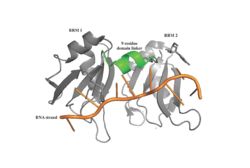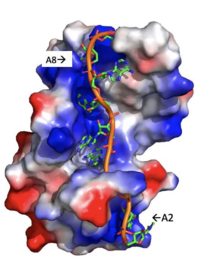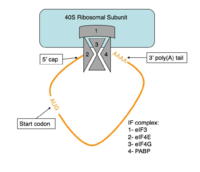Poly(A) binding protein
From Proteopedia
(Difference between revisions)
| Line 29: | Line 29: | ||
The initiation of translation in eukaryotes requires many translation factors and proteins, one of which is PABP. There is evidence that PABP is critical for formation of the “closed loop” model of protein synthesis, which involves joining the 3’ poly (A) tail of mRNA to the 5’ cap to create circular RNA [4]. This process utilizes eIF4F, a protein composed of multiple translation factors that play various roles in translation. eIF4G is a scaffolding protein that binds the other subunits, eIF4E and eIF4A. eIF4E creates interactions with the 5’ cap to bring the initiation factor (IF) complex to the 5’ end of the mRNA. eIF4G also has a binding site for PABP, which is N-terminal to the binding site for eIF4F and interacts with the same RRMs that allow PABP to bind RNA. <ref name="Rotavirus"> Piron, M. “Rotavirus RNA-Binding Protein NSP3 Interacts with eIF4GI and Evicts the Poly(A) Binding Protein from eIF4F.” The EMBO Journal, vol. 17, no. 19, 1998, pp. 5811–5821., doi:10.1093/emboj/17.19.5811. </ref> All of these proteins are known to be involved in protein synthesis, but several mechanisms have been proposed for how PABP might be promoting translation. | The initiation of translation in eukaryotes requires many translation factors and proteins, one of which is PABP. There is evidence that PABP is critical for formation of the “closed loop” model of protein synthesis, which involves joining the 3’ poly (A) tail of mRNA to the 5’ cap to create circular RNA [4]. This process utilizes eIF4F, a protein composed of multiple translation factors that play various roles in translation. eIF4G is a scaffolding protein that binds the other subunits, eIF4E and eIF4A. eIF4E creates interactions with the 5’ cap to bring the initiation factor (IF) complex to the 5’ end of the mRNA. eIF4G also has a binding site for PABP, which is N-terminal to the binding site for eIF4F and interacts with the same RRMs that allow PABP to bind RNA. <ref name="Rotavirus"> Piron, M. “Rotavirus RNA-Binding Protein NSP3 Interacts with eIF4GI and Evicts the Poly(A) Binding Protein from eIF4F.” The EMBO Journal, vol. 17, no. 19, 1998, pp. 5811–5821., doi:10.1093/emboj/17.19.5811. </ref> All of these proteins are known to be involved in protein synthesis, but several mechanisms have been proposed for how PABP might be promoting translation. | ||
| - | One of the mechanisms that PABP has been shown to assist in the initiation of protein synthesis is by interaction with eIF4G. The results of Kahvejian et al. were able to show that not only might PABP be acting as a translation factor in eukaryotic cells, but it also needs to interact with eIF4G in order to have an effect. | + | One of the mechanisms that PABP has been shown to assist in the initiation of protein synthesis is by interaction with eIF4G. The results of Kahvejian et al. were able to show that not only might PABP be acting as a translation factor in eukaryotic cells, but it also needs to interact with eIF4G in order to have an effect <ref name="kahvejian"> Kahvejian, A. “Mammalian Poly(A)-Binding Protein Is a Eukaryotic Translation Initiation Factor, Which Acts via Multiple Mechanisms.” Genes & Development, vol. 19, no. 1, 2005, pp. 104–113., doi:10.1101/gad.1262905.</ref>. |
Furthermore, PABP interactions have been shown to be critical for the formation of the 80S ribosomal subunit. PABP is essential in recruiting both the 40S and the 60S ribosomal subunit for the initiation of translation[6]. Because of this, PABP affects the formation of the 80S ribosome complex in two ways: indirectly, by allowing the 40S subunit to be available to bind, and directly, by promoting association of the 60S subunit with the 40S subunit. | Furthermore, PABP interactions have been shown to be critical for the formation of the 80S ribosomal subunit. PABP is essential in recruiting both the 40S and the 60S ribosomal subunit for the initiation of translation[6]. Because of this, PABP affects the formation of the 80S ribosome complex in two ways: indirectly, by allowing the 40S subunit to be available to bind, and directly, by promoting association of the 60S subunit with the 40S subunit. | ||
| Line 38: | Line 38: | ||
The RRMs support interactions with the interacting proteins such as eIF4G and [https://en.wikipedia.org/wiki/PAIP1 PAIP-1], however, the specific ways in which PABP interacts with these proteins are not structurally proven. However, there is a convex dorsal surface present on the RRM 1 and 2 motifs formed by the two α-helices in each RRM, specified as H1 and H2 in RRM1 and H1' and H2' in RRM2. This surface contains a sequence portion of <scene name='78/781947/H1_and_h2_h2ophobic_residues/2'>Conserved Hydrophobic Residues</scene>and <scene name='78/781947/Hydrophilic_residues/2'>Conserved Acidic Residues</scene> | The RRMs support interactions with the interacting proteins such as eIF4G and [https://en.wikipedia.org/wiki/PAIP1 PAIP-1], however, the specific ways in which PABP interacts with these proteins are not structurally proven. However, there is a convex dorsal surface present on the RRM 1 and 2 motifs formed by the two α-helices in each RRM, specified as H1 and H2 in RRM1 and H1' and H2' in RRM2. This surface contains a sequence portion of <scene name='78/781947/H1_and_h2_h2ophobic_residues/2'>Conserved Hydrophobic Residues</scene>and <scene name='78/781947/Hydrophilic_residues/2'>Conserved Acidic Residues</scene> | ||
| - | residues. It is thought that this area of conservation thus produces overlapping binding sites to interact with eIF4G and PAIP-1. For example, the conserved acidic residues may be beneficial to be used in to interact with essential basic residues present in both eIF4G and PAIP-1 via ionic interactions <ref name="PABP"/>. While there are only proposed mechanisms for how PABP promotes the initiation of translation in Homo sapiens, there is a pathogenic [https://en.wikipedia.org/wiki/Protozoa protozoan], Leishmania, that through a study done by Osvaldo P. de Melo Neto et. al, a site on the domain linker of a PABP homolog, PABP-1, of either serine-proline or threonine-proline residues which an eIF4F-like complex [https://en.wikipedia.org/wiki/Phosphorylation phosphorylates]. The authors suggest that this phosphorylation is part of how PABP-1 aids the eIF4F complex in initiating translation. They supported this by removing the gene that encodes PABP-1 and the results showed that the protozoan could not initiated cell growth and therefore survive without the PABP-1 gene. The homo sapiens' PABP also contain a (<scene name='78/781947/Pro-ser_in_linker/2'>Serine-Proline</scene>) site on the domain linker which could be interacting with the eIF4 complex in a similar way as in Leishmania protozoan | + | residues. It is thought that this area of conservation thus produces overlapping binding sites to interact with eIF4G and PAIP-1. For example, the conserved acidic residues may be beneficial to be used in to interact with essential basic residues present in both eIF4G and PAIP-1 via ionic interactions <ref name="PABP"/>. While there are only proposed mechanisms for how PABP promotes the initiation of translation in Homo sapiens, there is a pathogenic [https://en.wikipedia.org/wiki/Protozoa protozoan], Leishmania, that through a study done by Osvaldo P. de Melo Neto et. al, a site on the domain linker of a PABP homolog, PABP-1, of either serine-proline or threonine-proline residues which an eIF4F-like complex [https://en.wikipedia.org/wiki/Phosphorylation phosphorylates]. The authors suggest that this phosphorylation is part of how PABP-1 aids the eIF4F complex in initiating translation. They supported this by removing the gene that encodes PABP-1 and the results showed that the protozoan could not initiated cell growth and therefore survive without the PABP-1 gene. The homo sapiens' PABP also contain a (<scene name='78/781947/Pro-ser_in_linker/2'>Serine-Proline</scene>) site on the domain linker which could be interacting with the eIF4 complex in a similar way as in Leishmania protozoan <ref name="Osvaldo"/>De Melo Neto, Osvaldo P., et al. “Phosphorylation and Interactions Associated with the Control of the Leishmania Poly-A Binding Protein 1 (PABP1) Function during Translation Initiation.” RNA Biology, 23 Mar. 2018, pp. 1–17., doi:10.1080/15476286.2018.1445958.</ref>. |
| + | |||
Revision as of 16:29, 3 April 2018
Poly(A) binding protein
| |||||||||||



